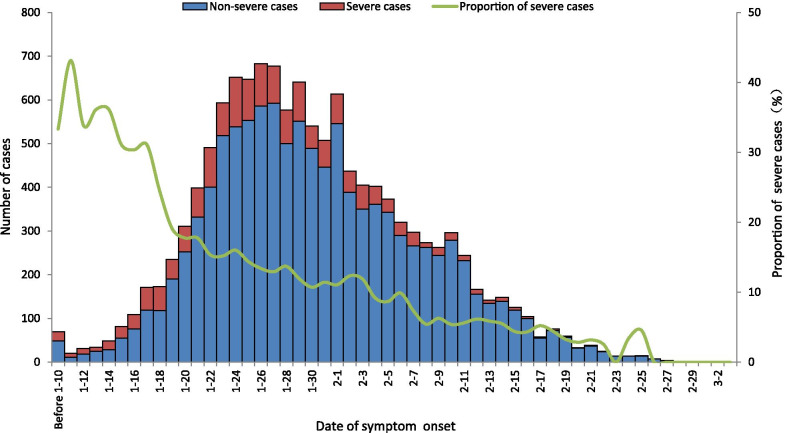- Record: found
- Abstract: found
- Article: found
Risk factors for developing severe COVID-19 in China: an analysis of disease surveillance data

Read this article at
Abstract
Background
COVID-19 has posed an enormous threat to public health around the world. Some severe and critical cases have bad prognoses and high case fatality rates, unraveling risk factors for severe COVID-19 are of significance for predicting and preventing illness progression, and reducing case fatality rates. Our study focused on analyzing characteristics of COVID-19 cases and exploring risk factors for developing severe COVID-19.
Methods
The data for this study was disease surveillance data on symptomatic cases of COVID-19 reported from 30 provinces in China between January 19 and March 9, 2020, which included demographics, dates of symptom onset, clinical manifestations at the time of diagnosis, laboratory findings, radiographic findings, underlying disease history, and exposure history. We grouped mild and moderate cases together as non-severe cases and categorized severe and critical cases together as severe cases. We compared characteristics of severe cases and non-severe cases of COVID-19 and explored risk factors for severity.
Results
The total number of cases were 12 647 with age from less than 1 year old to 99 years old. The severe cases were 1662 (13.1%), the median age of severe cases was 57 years [Inter-quartile range(IQR): 46–68] and the median age of non-severe cases was 43 years (IQR: 32–54). The risk factors for severe COVID-19 were being male [adjusted odds ratio (a OR) = 1.3, 95% CI: 1.2–1.5]; fever (a OR = 2.3, 95% CI: 2.0–2.7), cough (a OR = 1.4, 95% CI: 1.2–1.6), fatigue (a OR = 1.3, 95% CI: 1.2–1.5), and chronic kidney disease (a OR = 2.5, 95% CI: 1.4–4.6), hypertension (a OR = 1.5, 95% CI: 1.2–1.8) and diabetes (a OR = 1.96, 95% CI: 1.6–2.4). With the increase of age, risk for the severity was gradually higher [20–39 years (a OR = 3.9, 95% CI: 1.8–8.4), 40–59 years (a OR = 7.6, 95% CI: 3.6–16.3), ≥ 60 years (a OR = 20.4, 95% CI: 9.5–43.7)], and longer time from symtem onset to diagnosis [3–5 days (a OR = 1.4, 95% CI: 1.2–1.7), 6–8 days (a OR = 1.8, 95% CI: 1.5–2.1), ≥ 9 days(a OR = 1.9, 95% CI: 1.6–2.3)].
Conclusions
Our study showed the risk factors for developing severe COVID-19 with large sample size, which included being male, older age, fever, cough, fatigue, delayed diagnosis, hypertension, diabetes, chronic kidney diasease, early case identification and prompt medical care. Based on these factors, the severity of COVID-19 cases can be predicted. So cases with these risk factors should be paid more attention to prevent severity.

Related collections
Most cited references43
- Record: found
- Abstract: found
- Article: not found
Clinical Characteristics of Coronavirus Disease 2019 in China
- Record: found
- Abstract: found
- Article: not found
Clinical course and risk factors for mortality of adult inpatients with COVID-19 in Wuhan, China: a retrospective cohort study
- Record: found
- Abstract: found
- Article: not found